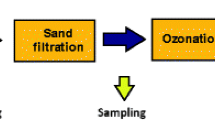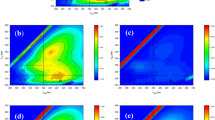Abstract
This paper focused on the removal and transformation of the dissolved organic matter (DOM) in secondary effluent during the granular activated carbon (GAC) treatment. Using XAD-8/XAD-4 resins, DOM was fractionated into five classes: hydrophobic acid (HPO-A), hydrophobic neutral (HPO-N), transphilic acid (TPI-A), transphilic neutral (TPI-N) and hydrophilic fraction (HPI). Subsequently, the water quality parameters of dissolved organic carbon (DOC), absorbance of ultraviolet light at 254 nm (UV-254), specific ultraviolet light absorbance (SUVA) and trihalomethane formation potential (THMFP) were analyzed for the unfractionated and fractionated water samples. The results showed that the order of the DOC removal with respect to DOM fractions was observed to be HPI>HPO-A>HPO-N>TPI-A>TPI-N. During the GAC treatment, the THMFP of the unfractionated water samples decreased from 397.4 μg/L to 176.5 μg/L, resulting in a removal efficiency of 55.6%. The removal order of the trihalomethanes (THMs) precursor was as follows: HPO-A>TPI-A>TPI-N>HPO-N>HPI. By the GAC treatment, the specific THMFP of HPO-A, TPI-A, TPI-N and the original unfractionated water samples had a noticeable decrease, while that of HPO-N and HPI showed a converse trend. The Fourier transform infrared (FTIR) results showed that the hydroxide groups, carboxylic acids, aliphatic C—H were significantly reduced by GAC treatment.
Similar content being viewed by others
References
Aiken, G.R., McKnight, D.M., Thorn, K.A., Thurman, E.M., 1992. Isolation of hydrophilic organic acids from water using nonionic macroporous resins. Organic Geochemistry, 18(4):567–573. [doi:10.1016/0146-6380(92)90119-I]
Amy, G., Cho, J., 1999. Interactions between natural organic matter (NOM) and membranes: rejection and fouling. Water Science and Technology, 40(9):131–139. [doi:10.1016/S0273-1223(99)00649-6]
APHA (American Public Health Association), 1987. Standard Methods for the Examination of Water and Wastewater. Washington, DC.
Chen, H.H., Yeh, H.H., Shiau, S., 2005. The membrane application on the wastewater reclamation and reuse from the effluent of industrial WWTP in northern Taiwan. Desalination, 185(1–3):227–239. [doi:10.1016/j.desal.2005.03.079]
Cheng, W., Dastgheib, S.A., Karanfil, T., 2005. Adsorption of dissolved natural organic matter by modified activated carbons. Water Research, 39(11):2281–2290. [doi:10.1016/j.watres.2005.01.031]
Chow, A.T., Tanji, K.K., Gao, S.D., 2003. Production of dissolved organic carbon (DOC) and trihalomethane (THM) precursor from peat soils. Water Research, 37(18):4475–4485. [doi:10.1016/S0043-1354(03)00437-8]
Chow, A.T., Guo, F.M., Gao, S.D., Breuer, R., Dahlgren, R.A., 2005. Filter pore size selection for characterizing dissolved organic carbon and trihalomethane precursors from soils. Water Research, 39(7):1255–1264. [doi:10.1016/j.watres.2005.01.004]
Cloirec, P.L., Brasquet, C., Subrenat, E., 1997. Adsorption onto fibrous activated carbon: applications to water treatment. Energy Fuels, 11(2):331–336. [doi:10.1021/ef9601430]
Croue, J.P., Violleau, D., Labouyrie, L., 2000. Disinfection Byproduct Formation Potentials of Hydrophobic and Hydrophilic Natural Organic Matter Fractions: a Comparison Between a Low-and a High-humic Water. In: Barrett, S.E., Krasner, S.W., Amy, G.L. (Eds.), Natural Organic Matter and Disinfection By-Products—Characterization and Control in Drinking Water. ACS Symposium Series 761, American Chemical Society, Washington, DC.
Galapate, R.P., Baes, A.U., Okada, M., 2001. Transformation of dissolved organic matter during ozonation effects on trihalomethane formation potential. Water Research, 35(9):2201–2206. [doi:10.1016/S0043-1354(00)00489-9]
Goi, D., Tubaro, F., Barbone, F., Dolcetti, G., Bontempelli, G., 2005. Evaluation of chlorinated by-products in drinking waters of central Friuli (Italy). Annali di Chimica, 95(9-10):617–627. [doi:10.1002/adic.200590073]
Her, N., Amy, G., McKnight, D., Sohn, J.S., Yoon, Y.M., 2003. Characterization of DOM as a function of MW by fluorescence EEM and HPLC-SEC using UVA, DOC, and fluorescence detection. Water Research, 37(17):4295–4303. [doi:10.1016/S0043-1354(03)00317-8]
Imai, A., Takehiko, F., Kazuo, M., Kim, Y.H., 2001. Fractionation and characterization of dissolved organic matter in a shallow eutrophic lake, its inflowing rivers, and other organic matter sources. Water Research, 35(17):4019–4028. [doi:10.1016/S0043-1354(01)00139-7]
Imai, A., Kazuo, M., Takashi, N., 2003. Trihalomethane formation potential of dissolved organic matter in a shallow eutrophic lake. Water Research, 37(17):4284–4294. [doi:10.1016/S0043-1354(03)00310-5]
Karanfil, T., Kitis, M., Kilduff, J.E., Wigton, A., 1999. Role of granular activated carbon surface chemistry on the adsorption of organic compounds. 2. Natural organic matter. Environmental Science and Technology, 33(18):3225–3233. [doi:10.1021/es9810179]
Karanfil, T., Erdogan, I., Schlautman, M.A., 2003. Selecting filter membranes for measuring DOC and UV 254. American Water Works Association, 95(3):86–100.
Kim, H.C., Yu, M.J., 2005a. Characterization of natural organic matter in conventional water treatment processes for selection of treatment processes focused on DBPs control. Water Research, 39(19):4779–4789. [doi:10.1016/j.watres. 2005.09.021]
Kim, M.H., Yu, M.J., 2005b. Characterization of NOM in the Han River and evaluation of treatability using UF-NF membrane. Environmental Research, 97(1):116–123. [doi:10.1016/j.envres.2004.07.012]
Kim, Y.J., Osako, M., 2004. Investigation on the humification of municipal solid waste incineration residue and its effect on the leaching behavior of dioxins. Waste Management, 24(8):815–823. [doi:10.1016/j.wasman.2004.04.004]
Leenheer, J.A., 1981. Comprehensive approach to preparative isolation and fractionation of dissolved organic carbon from natural waters and wastewaters. Environmental Science and Technology, 15(5):578–587. [doi:10.1021/es00087a010]
Leenheer, J.A., Croué, J.P., 2003. Characterizing dissolved aquatic organic matter. Environmental Science and Technology, 37(1):18A–26A.
Lin, C.F., Liu, S.H., Hao, O.J., 2001. Effect of functional groups of humic substances on UF performance. Water Research, 35(10):2395–2402. [doi:10.1016/S0043-1354(00)00525-X]
Ma, H.Z., Herbert, E.A, Yin, Y.J., 2001. Characterization of isolated fractions of dissolved organic matter from natural waters and a wastewater effluent. Water Research, 35(4):985–996. [doi:10.1016/S0043-1354(00)00350-X]
Maurice, P.A., Pullin, M.J., Cabaniss, S.E., 2002. A comparison of surface water natural organic matter in raw filtered water samples, XAD, and reverse osmosis isolates. Water Research, 36(9):2357–2371. [doi:10.1016/S0043-1354(01)00442-0]
McGeehin, M.A., Reif, J.S., Becher, J.C., Mangione, E.J., 1993. Case-control study of bladder cancer and water disinfection methods in Colorado. Epidemiology, 138(7): 492–501.
Newcombe, G., Drikas, M., Hayes, R., 1997. Influence of characterized natural organic material on activated carbon adsorption: II effect on pore volume distribution and adsorption of 2-methylisoborneol. Water Research, 31(5): 1065–1073. [doi:10.1016/S0043-1354(96)00325-9]
Quanrud, D.M., Arnold, R.G., Wilson, L.G., Martha, H.C., Conklin, M.H., 1996. Effect of soil type on water quality improvement during soil aquifer treatment. Water Science and Technology, 33(10–11):419–431. [doi:10.1016/0273-1223(96)00445-3]
Rebhun, M., Goodman, N.L., Barker, F.B., 1987. Monitoring and study program of an interregional wastewater reclamation system for agriculture. Journal Water Pollution Control Federation, 59(5):242–248.
Reckhow, D.A., Singer, P.C., Malcolm, R.L., 1990. Chlorination of humic materials: byproduct formation and chemical interpretations. Environmental Science and Technology, 24(11):1655–1664. [doi:10.1021/es00081a-005]
Schreiber, B., Brinkmann, T., Schmalz, V., Worch, E., 2005. Adsorption of dissolved organic matter onto activated carbon—the influence of temperature, absorption wave-length, and molecular size. Water Research, 39(15):3449–3456. [doi:10.1016/j.watres.2005.05.050]
Thurman, E.M., Malcolm, R.L., 1981. Preparative isolation of aquatic humic substances. Environmental Science and Technology, 15(4):463–466. [doi:10.1021/es00086a 012]
Vahala, R., Langvik, V.A., Laukkanen, R., 1999. Controlling adsorbable organic halogens (AOX) and trihalomethanes (THM) formation by ozonation and two-step granule activated carbon (GAC) filtration. Water Science and Technology, 40(9):249–256. [doi:10.1016/S0273-1223(99)00663-0]
Villanueva, C.M., Kogevinasa, M., Grimaltb, J.O., 2003. Haloacetic acids and trihalomethanes in finished drinking waters from heterogeneous sources. Water Research, 37(4):953–958. [doi:10.1016/S0043-1354(02)00411-6]
Westerhoff, P., Chao, P., Mash, H., 2004. Reactivity of natural organic matter with aqueous chlorine and bromine. Water Research, 38(6):1502–1513. [doi:10.1016/j.watres.2003.12.014]
White, D.M., Garland, D.S., Narr, J., Woolard, C.R., 2003. Natural organic matter and DBP formation potential in Alaskan water supplies. Water Research, 37(4):939–947. [doi:10.1016/S0043-1354(02)00425-6]
Xue, S., Zhao, Q.L., Wei, L.L., Wang, L.N., Liu, Z.G., 2007. Fate of secondary effluent dissolved organic matter during soil-aquifer treatment. Chinese Science Bulletin, 52(18):2496–2505. [doi:10.1007/s11434-007-0339-1]
Zhao, Q.L., Xue, S., You, S.J., Wang, L.N., 2007. Removal and transformation of organic matter during soil-aquifer treatment. Journal of Zhejiang University SCIENCE A, 8(5):712–718. [doi:10.1631/jzus.2007.A0712]
Author information
Authors and Affiliations
Corresponding author
Additional information
Project (No. 2004CB418505) supported by the National Basic Research Program (973) of China
Rights and permissions
About this article
Cite this article
Wei, Ll., Zhao, Ql., Xue, S. et al. Removal and transformation of dissolved organic matter in secondary effluent during granular activated carbon treatment. J. Zhejiang Univ. Sci. A 9, 994–1003 (2008). https://doi.org/10.1631/jzus.A071508
Received:
Accepted:
Published:
Issue Date:
DOI: https://doi.org/10.1631/jzus.A071508
Key words
- Dissolved organic matter (DOM)
- Fractionation
- Trihalomethane formation potential (THMFP)
- Specific THMFP
- Fourier-transform infrared (FTIR)




